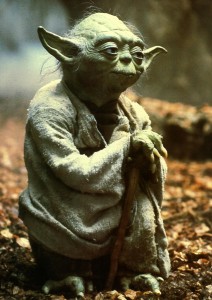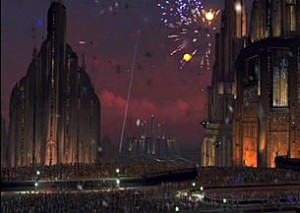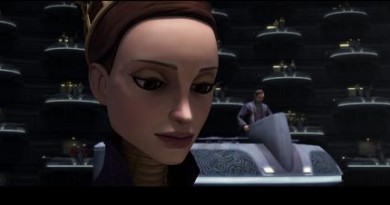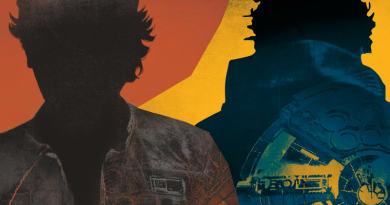Path Dependence in Star Wars Storytelling
In many fields, from history and economics to computing, the concept of path dependence plays a role in the analysis of certain kinds of situations. Although the specific implications of the term vary by discipline, the key idea is the same: sometimes when a fork in the road occurs and one path is traveled, it can be nearly impossible to revisit that decision-point even if subsequent events reveal that the other path would be superior.
 A commonly cited example is the QWERTY keyboard. The design has long since outlived its necessity from the era of mechanical typewriters, and other alphabetical layouts likely would be more optimal for digital technology with no physical limitations on typing speed – much less for smartphone touchscreens typed with a pair of thumbs, not a full span of two hands. Yet QWERTY persists to this day on millions of new devices of all types sold every year.
A commonly cited example is the QWERTY keyboard. The design has long since outlived its necessity from the era of mechanical typewriters, and other alphabetical layouts likely would be more optimal for digital technology with no physical limitations on typing speed – much less for smartphone touchscreens typed with a pair of thumbs, not a full span of two hands. Yet QWERTY persists to this day on millions of new devices of all types sold every year.
Path dependence also occurs in storytelling. Decisions made at early points in a story have consequences later in the tale – a character dies, an object is destroyed, information is learned, an alliance is formed. If these storytelling choices are not made thoughtfully, storytellers find themselves blocked from taking a direction they would prefer because the barriers laid down by the prior path of the tale prevent it.
In Star Wars lore, Yoda famously described a variation on path dependence, too: “Once you set foot down the dark path, forever will it dominate your destiny.” Path dependence has a long history in prior Star Wars stories, and its impact will be felt on all of the new Star Wars stories coming in the years ahead.
The Expanded Universe
The Legends tales told in the Expanded Universe included numerous instances of path dependence impacting the progression of the storylines. A few prominent examples provide good illustrations.
Any serial storytelling necessarily will set down paths that limit subsequent options in the later continuity, and the EU was no exception. During the initial Bantam era of Star Wars novels (1991-1998), no master plan existed to direct the development of the stories. In the very first book, Heir to the Empire, Han and Leia were established as already married; twins Jaina and Jacen were born in the second book, Dark Force Rising, in 9 ABY. After the first sparks flew between Luke and Mara in the same series, though, the EU took until 19 ABY to reach their marriage in the comic Unionand 27 ABY for the birth of their son, Ben, in The New Jedi Order: Edge of Victory: Rebirth. As a consequence, the flagship storyline was stuck with Solo and Skywalker heirs who were roughly a full generation apart in age; likewise, with Mara already in her late forties, only a single Skywalker child was born. To enable those characters to interact, the stories were rapidly accelerated down the timeline to place Jaina and Jacen in their thirties and Ben in his teens; the EU included only three novels for the Solo twins in their sweet-spot heroic ages of 21-31 years old. The ad hoc progression of the EU novels inadvertently squandered the opportunity to portray next-generation Solos and Skywalkers as peers.
Path dependence produced this outcome – surely not an optimal one for the stories or their fans – through unintended consequences of unplanned story development. Now that a central Story Group has responsibility for creating Star Wars stories, though, this kind of negative impact of path dependence can be avoided. The Story Group will be able to consider the full ramifications of story decisions like character ages from the beginning, and then make collective decisions that benefit long-term storytelling across the franchise.
Other examples show the influence of real-world factors on the paths created for in-universe story development. When authors began creating the first novels and comics in the early 1990s, the authors obviously knew nothing about the Old Jedi Order because the Prequel Trilogy had not been created yet; they were limited to what Obi-Wan and Yoda had said in the Original Trilogy.  Consequently, Luke Skywalker couldn’t know anything more than that about the ways of the Jedi, either. While this allowed the authors to be creative in rebuilding a new Jedi Order, it also culminated in substantial dissonance with George Lucas’ movies. As one solution to the authors’ lack of knowledge, the books hypothesized that the Emperor would have destroyed all knowledge and records of the Jedi Order. This turned out to be problematic even before the Prequels came out, when the 1997 revised ending to the Special Edition of Return of the Jedi showed that the Jedi Temple on Coruscant had not been destroyed after all.
Consequently, Luke Skywalker couldn’t know anything more than that about the ways of the Jedi, either. While this allowed the authors to be creative in rebuilding a new Jedi Order, it also culminated in substantial dissonance with George Lucas’ movies. As one solution to the authors’ lack of knowledge, the books hypothesized that the Emperor would have destroyed all knowledge and records of the Jedi Order. This turned out to be problematic even before the Prequels came out, when the 1997 revised ending to the Special Edition of Return of the Jedi showed that the Jedi Temple on Coruscant had not been destroyed after all.
Similarly, the EU authors didn’t know the definitive backstory of Luke’s and Leia’s parents until 2005’s Revenge of the Sith, so the characters also couldn’t have learned anything about their mother or any details of their father’s past. When they finally did acquire that information in 35 ABY’s Dark Nest trilogy, EU fans witnessed ham-handed exposition by means of holorecordings supposedly concealed the whole time within R2-D2’s memory banks.
In the forthcoming tales created to accompany the Sequel Trilogy, including new canon stories set between Return of the Jedi and Episode VII, such forms of path dependence will not limit the storytellers. The Prequel Trilogy and The Clone Wars showed that holocrons can be used to convey the wisdom and knowledge of the Jedi even without living Jedi Masters available. After his epiphanies in his iconic Season Six arc, perhaps Yoda was even able to record the lessons he discovered about the flaws of the Old Jedi Order to enable future Jedi to avoid those errors. Following the EU’s lead, Star Wars Rebels will include an Order 66 survivor training a new apprentice. Whatever the state of the Jedi in the Sequel Trilogy, storytellers will be able to link up similarities and differences to the Prequel era Order with full knowledge of the saga’s backstory.
Likewise, with only a twenty-five year gap between Revenge of the Sith and Return of the Jedi, instead of the much longer timeframe previously inferred in the EU, it would be simple to explain how Luke and Leia learned about Padmé, their Naboo heritage, and more details of the personal and political history of the Prequel period. Perhaps Bail Organa left an “In Case of My Death” holorecording with Mon Mothma – or perhaps Mothma herself already knew who Leia’s birth parents were. For years, fanficcers have fancied the idea that Padmé’s close friend Sabé, her decoy in The Phantom Menace, remained a dear friend to Padmé and traveled to Alderaan to help raise and train Leia throughout her formative years; with a bit of good fortune to survive the planet’s obliteration by the Death Star, Sabé easily could still be alive at the time of Episode VII, much less have been around to tell Leia and Luke about their ancestry in the years soon after Endor. With the backstory of the Prequel era now fully known to the creators of the Sequel Trilogy and all other new canon stories, path dependence will not impose real-world limits on their ability to reference the events, characters, and themes of that period as much as they desire.
A final example shows the meta-level effects of path dependence on the franchise. From 2002-2005, roughly in the “real time” of three in-universe years mirroring the real-world time between Attack of the Clones and Revenge of the Sith, Lucasfilm released a collaborative, integrated multi-media saga of the Clone Wars including comics, books, videogames, and the animated micro-series. When George Lucas’ The Clone Wars began in 2008, however, it quickly became clear that the two versions of the war would not easily be reconciled – most visibly in the form of Anakin’s apprentice Ahsoka Tano, but also in terms of timeline, characterizations, and much more. At the time, Lucasfilm continued to maintain its longstanding public position that Star Wars had a “single continuity” and would not reboot.
 Although some fans endeavored to craft retconned chronologies integrating both version of the war, Lucasfilm remained studiously silent on the matter until the publication of The Essential Readers Companion, by Lucasfilm EU guru Pablo Hidalgo, on October 2, 2012. On page ix, the book elaborated on the single EU continuity and its relationship to the cinematic canon. In Chapter Three, it offered officially sanctioned retcons to the in-universe timeline placements for the original Clone Wars books and prose short stories to attempt to reconcile them with The Clone Wars animated series.
Although some fans endeavored to craft retconned chronologies integrating both version of the war, Lucasfilm remained studiously silent on the matter until the publication of The Essential Readers Companion, by Lucasfilm EU guru Pablo Hidalgo, on October 2, 2012. On page ix, the book elaborated on the single EU continuity and its relationship to the cinematic canon. In Chapter Three, it offered officially sanctioned retcons to the in-universe timeline placements for the original Clone Wars books and prose short stories to attempt to reconcile them with The Clone Wars animated series.
Within weeks, Disney’s purchase of Lucasfilm and the production of new Star Wars movies was announced on October 30, 2012. Although the implications to the EU were immediately obvious, the official word finally came on April 25, 2014, albeit without using the word “reboot” in the announcement. The existing Expanded Universe was being rebranded as Legends – and the Sequel Trilogy and all other future Star Wars stories would proceed to create a new canon saga unbounded to the previous tales.
In today’s light, the Clone Wars chapter of The Essential Readers Companion is a pointless anachronism. Now the 2002-2005 Clone Wars EU has retroactively become part of the Legends storyline. The company policy that generated the attempt to reconcile it with the animated series by forcing awkward retcons no longer exists; the Legends Clone Wars and The Clone Wars are simply parallel timelines portraying alternate versions of the conflict. No different than how the post-Return of the Jedi stories created in 2015 and beyond will become an alternative timeline to the 1991-2014 Legends EU, the Clone Wars EU materials once again are free to stand as an independent self-contained whole as originally created. Yet at the time of the Readers Companion’s writing and publication, path dependence compelled Hidalgo to adhere to the single continuity mindset in his tome.
The Sequel Trilogy and Beyond
With the clean slate offered by the development of new stories unbound to tales told in the previous Legends timeline, storytelling in the Star Wars saga hasn’t faced this amount of creative freedom since 1984. While Episode VII and the rest of the Sequel Trilogy are the pinnacle, the saga also looks ahead to standalone films, television series beginning with Star Wars Rebels, and books and comics afforded equal canon status with the cinematic media. It is certainly an exciting time to be a Star Wars fan.
In merely a few years, though, Star Wars stories will be emerging at a rapid pace again – and path dependence once more will begin to limit the storytellers’ creative freedom in many significant ways. Most notably, the post-Return of the Jedi backstory created for Episode VII will constrain all stories told during the thirty-year span after the Battle of Endor. Fortunately, Kathleen Kennedy acted swiftly to forestall a recurrence of the unintended consequences of ad hoc storytelling that pervaded the EU’s progression by convening the Story Group to oversee the development of all Star Wars storytelling.
Although it will take years to even approach the extent of the details that the Legends EU created, many of the core characterization elements were immediately placed back on the table by the EU reboot. The biggest ones cannot avoid prompt resolution in developing Episode VII and the Sequel Trilogy:
- Did Leia and Han get married? If so, when? If not, did either of them marry someone else instead? If so, to whom and when?
- How many children do Leia and Han have, separately or together? How old are they when Episode VII begins?
- Did Luke ever marry? Did he have children? If so, how many and when?
- How did Luke respond to Yoda’s exhortation to “pass on what you have learned”? How many new Jedi has he trained? When, where, and in what manner?
- Did Leia train as a Jedi? If so, when and for how long? Did she continue her political leadership career or focus on Jedi mastery?
- Did Luke and Leia keep their siblinghood a secret? Is it widely known in the galaxy, or just by their family and close associates?
- How many people know that Luke and Leia are the children of Anakin Skywalker and Padmé Amidala? For each person who knows, how did they find out?
- How many people besides Luke and Leia know that Darth Vader and Anakin Skywalker were the same person? Did they tell anyone? Who within the Empire might have known, to be able to reveal it after Endor?
At this point, of course, only rumors and speculation offer any answers to fans on these questions. The Story Group and the screenwriters, though, surely had their decisions made many months ago. With the future of Star Wars storytelling in the balance, for now fans have to hope that the Story Group fully considered all of the implications of each decision carefully in deciding upon their answers. The core choices made now will create the new paths, and their inevitable ripple effects, on which so many Star Wars stories ahead will depend.
B.J. Priester is editor of FANgirl Blog and contributes reviews and posts on a range of topics. A longtime Star Wars fandom collaborator with Tricia, he edited her novel Wynde and is collaborating with her on several future projects set in that original universe. He is a law professor in Florida and a proud geek dad.
- BJ Priester Talks The Acolyte Episode 6 on Who’s the Bossk? - July 7, 2024
- Dave Filoni Talks Writing AHSOKA and Guiding the Future of Star Wars Storytelling - June 21, 2024
- Lessons in Franchise Management – MCU: The Reign of Marvel Studios - January 14, 2024










Pingback:Hyperspace Theories Episode Six: Jedi Masters Simon Kinberg and Luke Skywalker « FANgirl Blog